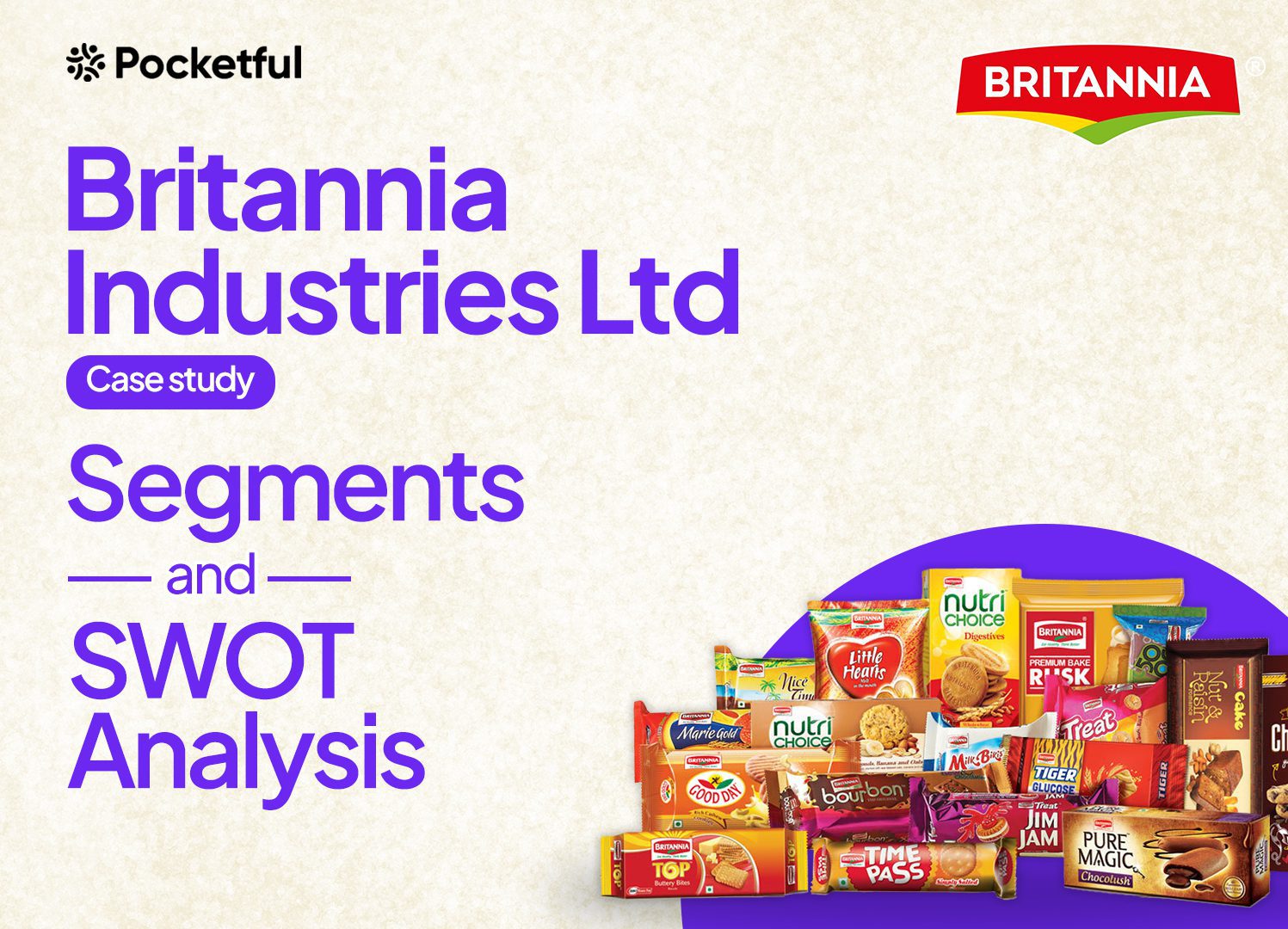| Type | Description | Contributor | Date |
|---|---|---|---|
| Post created | Pocketful Team | Apr-03-24 | |
| Add new links | Nisha | Apr-10-25 |

- Blog
- britannia industries ltd case study business segments kpis financials and swot analysis
Britannia Industries Ltd Case Study: Business Segments, KPIs, Financials, and SWOT Analysis

We all have experienced the brilliance of Britannia, but very few know its story. So today, we will explore Britannia’s success story. We’ll start with the company’s overview.
Britannia Industries Ltd Overview
Established in 1892, Britannia Industries Ltd. is one of India’s oldest food product companies and holds a significant position in the country’s biscuit industry. It is Kolkata-based and a part of the WADIA Group.
It is an iconic brand and reaches over 50% of Indian homes. Britannia has been in this business for over a century, building a loyal consumer base with strong and deep emotional connections. The company’s R&D team plays a vital role in maintaining and innovating a vast portfolio, ensuring it aligns with consumer preferences while prioritizing quality.
| Company Type | Public |
| Industry Type | Food |
| Founded | 1892 |
| Headquarters | Kolkata |
| Area served | Worldwide |
| Parent | Wadia Group |
Awards and Recognition
- 2011 – The Indian Merchants’ Chamber.
- 2012 – The Golden Peacock National Quality Award.
- 2014 – 100 Most Trusted Brands of India list.
- 2016 – Renewable Energy India Awards.
- 2019 – Brand Equity’s Most Trusted Brands.
- 2022 – Ranked 4th in the list of India’s most chosen FMCG brands.
Segments of Britannia Industries Ltd
Britannia Industries has served many finger-licking products. Such as:
- Biscuits: Britannia is one of the leading biscuit manufacturers in India, with popular brands such as NutriChoice, Milk Bikis, Bourbon, Good Day, 50-50, Marie Gold, Nice Time, and Little Hearts. Britannia biscuits are available in various segments, such as cookies, crackers, cream, health, and treats.
- Rusk: Britannia Rusk is a crispy and crunchy snack made from wheat flour, sugar, and butter and comes with various flavours of elaichi, milk, and suji toast
- Cakes: Britannia cakes include fruit cake, nut & raisin cake, chocolate cake, muffins, cupcakes, and brownies.
- Snacks: Britannia snacks are tasty and ideal for enjoyment anytime, anywhere. Britannia snacks include wafers, salted snacks, and nuts.
- Bread: Britannia Breads offers wheat bread, multigrain bread, fruit bread, sandwich bread, pav, bun, and kulcha. They are made from high-quality ingredients and are enriched with essential nutrients.

5 competitors of britannia biscuits
The company faces tough competition from the following players:
- Nestle
- Mother dairy
- TATA
- Parle
- Amul
Market Data
| Market Cap | ₹ 1,18,024 Cr. |
| TTM P/E | 54.64 |
| ROCE | 55.5 % |
| Book Value | ₹ 146.73 |
| ROE | 76.04 % |
| 52 Week High / Low | ₹ 5,386 / 4,222 |
| Dividend Yield | 1.47 % |
| Face Value | ₹ 1.00 |
Financial Highlights of Britannia Industries Ltd
Income Statement
| Particulars | Mar-23 | Mar-22 | Mar-21 | Mar-20 |
|---|---|---|---|---|
| Operating Revenue | 16,300.55 | 14,136.26 | 13,136.14 | 11,599.55 |
| Total Income | 16,516.41 | 14,359.09 | 13,449.01 | 11,878.95 |
| Total Expenditure | 13,469.64 | 11,934.75 | 10,626.85 | 9,756.37 |
| Profit before Tax | 3,032.77 | 2,078.33 | 2,513.61 | 1,844.30 |
| Consolidated Profit | 2,321.77 | 1,524.82 | 1,863.90 | 1,402.63 |
The graph indicates a growing trend in both Operating income and Net Profit. This shows a healthy state of the business.
Balance Sheet:
| Particulars | Mar-23 | Mar-22 | Mar-21 | Mar-20 |
|---|---|---|---|---|
| Non-Current Liabilities | 1,596.57 | 743.00 | 806.22 | 805.73 |
| Current Liabilities | 4,134.40 | 4,147.14 | 3,608.90 | 2,578.46 |
| Non-Current Assets | 4,549.24 | 3,493.44 | 3,579.66 | 4,147.70 |
| Current Assets | 4,746.23 | 3,982.30 | 4,419.46 | 3,674.97 |
The company has seen a consistent level of current liabilities but an increase in current assets. They have also witnessed an increase in non-current assets, which are primarily fueled by growing non-current liabilities.
Cash Flow Statement
| Particulars | Mar-23 | Mar-22 | Mar-21 | Mar-20 |
|---|---|---|---|---|
| Cash From Operating Activities | 2,526.21 | 1,299.52 | 1,875.52 | 1,484.53 |
| Cash Flow from Investing Activities | -1,517.06 | 910.89 | 435.62 | -1,531.62 |
| Cash from Financing Activities | -1,028.37 | -2,245.84 | -2,242.50 | 57.94 |
The Cash Flow situation indicates a strong operating position but a weak investing position. This means that the company invests heavily in the long run, which is financed by financing activities.
Profitability Ratios
| Particulars | Mar-23 | Mar-22 | Mar-21 | Mar-20 |
|---|---|---|---|---|
| ROCE (%) | 55.50 | 41.64 | 45.28 | 37.13 |
| ROE (%) | 76.04 | 49.89 | 46.92 | 32.40 |
| ROA (%) | 27.62 | 19.59 | 23.39 | 19.84 |
| EBIT Margin (%) | 15.98 | 14.15 | 17.60 | 14.30 |
| Net Margin (%) | 14.02 | 10.56 | 13.76 | 11.73 |
| Cash Profit Margin (%) | 14.90 | 11.63 | 14.89 | 12.90 |
Peer Comparison
| Particulars | Britannia | Mrs. Bectors | Dhunseri Ventures | Bambino Agro | Anjani Foods |
|---|---|---|---|---|---|
| Market cap (₹ Cr) | 1,18,337 | 6,554 | 1,131 | 268 | 84 |
| Revenue (₹ Cr) | 16,723 | 1,564 | 280 | 328 | 50 |
| Net Profit (₹ Cr) | 2,150.57 | 134.34 | 39.68 | 9.83 | 1.12 |
| Net Margin (%) | 12.70 | 8.50 | 11.18 | 2.98 | 2.24 |
| RoE (%) | 67.76 | 23.36 | 7.12 | 11.22 | 9.12 |
Read Also: Nestle India Case Study: Business Model, Financial Statement, SWOT Analysis
SWOT Analysis of Britannia Industries Ltd
This SWOT analysis of Britannia Company highlights its strong brand identity, extensive market presence, and effective 80:20 growth strategy driving significant revenue.

Strengths
- Britannia has been in the industry for more than 100 years. The company has created its space in every Indian household and a strong brand identity.
- The company used an 80:20 growth strategy where it focused on 20% of the brands like Marie Gold, Good Day, Milk Bikis & Nutri Choice, which contribute 80% of the company revenue. This process of putting some products on a priority list enabled the company to increase the efficiency of the production line.
- The company is working on new market innovations, which means adjusting the market according to consumer tastes and preferences. It helps to explore new flavours while leveraging current and new technologies.
Weaknesses
- Britannia is not able to maintain a proper overseas presence because of tough competition in the international market.
- The competitors in the Food Processing industry can easily imitate the business model.
Opportunities
- Accelerating technological innovation can lead to an increase in industrial productivity, allowing the company to capture greater market share.
- The company can choose to acquire other companies in the dairy industry to increase its market share.
Threats
- An increase in the price of the raw material will eventually increase the cost of the product, leading to a slowdown in sales.
- Changing political environments can impact the industry’s growth both in the local and international markets.
Read Also: Coal India Case Study: Products, Subsidiaries, Financials, KPIs, and SWOT Analysis
Conclusion
Britannia Industries Ltd has established itself as a prominent player in the Indian food industry with a strong brand identity and loyal consumer base. The company’s focus on key brands, innovation, and market adaptation presents growth opportunities, while challenges such as international competition and raw material price fluctuations pose threats to its continued success. Over the next five years, the company expects to increase the contribution of its non-biscuit portfolio to approximately 35% of total revenue, up from the current 23%. Additionally, there is an ambition to scale the dairy sector to ₹2,000 crore within the same time.
However, it is important to know that investing before conducting prior research can expose you to undue risks.
Frequently Asked Questions (FAQs)
What are the problems faced by Britannia?
The problems faced by Britannia are rising interest rates, high commodity prices, and geopolitical conflicts disrupting supply chains.
Who is the CEO of Britannia?
Rajneet Singh Kohli is the CEO of Britannia.
What is the market cap of Britannia Industries Ltd.?
As of 2nd April 24, the market cap of the company is ₹1,18,024 Cr.
What are the main segments of Britannia?
The company’s key segments are Biscuits, Rusk, Cakes, Snacks, and Bread.
What is the parent company of Britannia?
Wadia Group is the parent company of Britannia Industries Ltd.
Disclaimer
The securities, funds, and strategies discussed in this blog are provided for informational purposes only. They do not represent endorsements or recommendations. Investors should conduct their own research and seek professional advice before making any investment decisions.